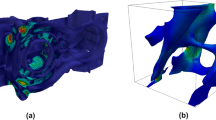Abstract
Explicit Runge-Kutta methods with the stability domains extended along the real axis are examined. For these methods, a simple and efficient procedure for calculating the stability polynomials is proposed. Three techniques for constructing methods with given stability polynomials are considered. Methods of the second and third orders are constructed, and their accuracy as applied to solving the Prothero-Robinson equation is examined. A comparison of the above methods on some test problems is performed.
Similar content being viewed by others
References
V. I. Lebedev, “How to Solve Stiff Systems of Differential Equations Using Explicit Methods,” in Vychislitel’nye Protsessy i Sistemy (Nauka, Moscow, 1991), No. 8, pp. 237–291 [in Russian].
V. I. Lebedev and A. A. Medovikov, “An Explicit Method of the Second Order of Accuracy for Stiff Systems of Ordinary Differential Equations,” Izv. Vyssh. Uchebn. Zaved., Mat., No. 9, 55–63 (1998).
V. I. Lebedev, “Explicit Difference Schemes for Solving Stiff Problems with a Complex or Separable Spectrum,” Zh. Vychisl. Mat. Mat. Fiz. 40(12), 1801–1812 (2000) [Comput. Math. Math. Phys. 40, 1729–1740 (2000)].
V. I. Lebedev, Functional Analysis and Computational Mathematics (Fizmatlit, Moscow, 2005) [in Russian].
E. Hairer and G. Wanner, Solving Ordinary Differential Equations, Vol. 2: Stiff and Differential-Algebraic Problems (Springer, Berlin, 1987–1991; Mir, Moscow, 1999).
J. G. Verwer, “Explicit Runge-Kutta Methods for Parabolic Partial Differential Equations,” Appl. Numer. Math. 22(1–3), 359–379 (1996).
B. P. Sommeijer, L. F. Shampine, and J. D. Verwer, “RKC: An Explicit Solver for Parabolic PDEs,” J. Comput. Appl. Math. 88, 315–326 (1997).
A. A. Medovikov, “Third Order Explicit Method for the Stiff Ordinary Differential Equations,” Lect. Notes Comput. Sci., Numerical Analysis and Its Applications 1196, 327–334 (Springer, 1997).
A. A. Medovikov, “High Order Explicit Methods for Parabolic Equations,” BIT 38, 372–390 (1998).
A. Abdulle and A. A. Medovikov, “Second Order Chebyshev Methods Based on Orthogonal Polynomials,” Numer. Math. 90(1), 1–18 (2001).
A. Abdulle, “Fourth Order Chebyshev Methods with Recurrence Relation,” SIAM J. Sci. Comput. 23, 2041–2054 (2002).
J. Martin-Vaquero and B. Janssen, “Second-Order Stabilized Explicit Runge-Kutta Methods for Stiff Problems,” Comput. Phys. Communs. 180, 1802–1810 (2009).
W. Riha, “Optimal Stability Polynomials,” Computing 9, 37–43 (1972).
A. Abdulle, “On Roots and Error Constants of Optimal Stability Polynomials,” BIT 40, 177–182 (2000).
A. B. Bogatyrev, “Efficient Solution of the Problem on the Best Stability Polynomial,” Mat. Sb. 196(7), 27–50 (2005).
V. I. Lebedev and S. A. Finogenov, “Utilization of Ordered Chebyshev Parameters in Iterative Methods,” Zh. Vychisl. Mat. Mat. Fiz. 16, 895–907 (1976) [USSR Comput. Math. Math. Phys. 16 (4), 70–83 (1976)].
A. Prothero and A. Robinson, “On the Stability and Accuracy of One-Step Methods for Solving Stiff Systems of Ordinary Differential Equations,” Math. Comput. 28(1), 145–162 (1974).
K. Dekker and J. G. Verwer, Stability of Runge-Kutta Methods for Stiff Nonlinear Differential Equations (North-Holland, Amsterdam, 1984; Mir, Moscow, 1988).
L. M. Skvortsov, “Increasing the Accuracy of Explicit Runge-Kutta Methods in Solving Moderately Stiff Problems,” Dokl. Akad. Nauk 378(5), 602–604 (2001) [Dokl. 63, 387–389 (2001)].
L. M. Skvortsov, “Accuracy of Runge-Kutta Methods Applied to Stiff Problems,” Zh. Vychisl. Mat. Mat. Fiz. 43, 1374–1384 (2003) [Comput. Math. Math. Phys. 43, 1320–1330 (2003)].
L. M. Skvortsov, “Explicit Runge-Kutta Methods for Moderately Stiff Problems,” Zh. Vychisl. Mat. Mat. Fiz. 45, 2017–2030 (2005) [Comput. Math. Math. Phys. 45, 1939–1951 (2005)].
O. S. Kozlov, D. E. Kondakov, L. M. Skvortsov, et al., “The Program Package Modelling in Engineering Devices, http://model.exponenta.ru/mvtu/20050615.html.
V. V. Voevodin and Yu. A. Kuznetsov, Matrices and Computations (Nauka, Moscow, 1984) [in Russian].
Author information
Authors and Affiliations
Corresponding author
Additional information
Original Russian Text © L.M. Skvortsov, 2011, published in Zhurnal Vychislitel’noi Matematiki i Matematicheskoi Fiziki, 2011, Vol. 51, No. 7, pp. 1236–1250.
Rights and permissions
About this article
Cite this article
Skvortsov, L.M. Explicit stabilized Runge-Kutta methods. Comput. Math. and Math. Phys. 51, 1153–1166 (2011). https://doi.org/10.1134/S0965542511070165
Received:
Published:
Issue Date:
DOI: https://doi.org/10.1134/S0965542511070165




